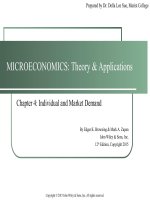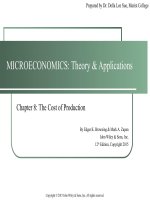MicroEconomics theory and application 12th by browning an zupan chapter 07
Bạn đang xem bản rút gọn của tài liệu. Xem và tải ngay bản đầy đủ của tài liệu tại đây (638.24 KB, 37 trang )
Prepared by Dr. Della Lee Sue, Marist College
MICROECONOMICS: Theory & Applications
Chapter 7: Production
By Edgar K. Browning & Mark A. Zupan
John Wiley & Sons, Inc.
12th Edition, Copyright 2015
Copyright © 2015 John Wiley & Sons, Inc. All rights reserved.
Learning Objectives
Establish the relationship between inputs and output.
Define total, average, and marginal product, and explain the law of diminishing
marginal returns in the short-run setting when at least some inputs are fixed.
Investigate the ability of a firm to vary its output in the long run when all inputs
are variable.
Explore returns to scale: how a firm’s output response is affected by a
proportionate change in all inputs.
Describe how production relationships can be estimated and some different
potential functional forms for those relationships.
Copyright © 2015 John Wiley & Sons, Inc. All rights reserved.
2
Establish the relationship between inputs and output.
7.1 RELATING OUTPUT TO INPUTS
Copyright © 2015 John Wiley & Sons, Inc. All rights reserved.
3
Relating Output to Inputs
Factors of production – inputs or ingredients mixed together by a firm through
its technology to produce output
Production function – a relationship between inputs and output that identifies
the maximum output that can be produced per time period by each specific
combination of inputs
Q = f(L,K)
Technologically efficient – a condition in which the firm produces the
maximum output from any given combination of labor and capital inputs
Copyright © 2015 John Wiley & Sons, Inc. All rights reserved.
4
Distinguish between variable and fixed inputs.
7.2 PRODUCTION WHEN ONLY ONE
INPUT IS VARIABLE:
THE SHORT RUN
Copyright © 2015 John Wiley & Sons, Inc. All rights reserved.
5
Production When Only One Input is
Variable: The Short Run
Fixed inputs - resources a firm cannot feasibly vary over the time period
involved
Total product - the total output of the firm
Average product - the total output (or total product) divided by the amount of
the input used to produce that output
Marginal product - the change in total output that results from a one-unit
change in the amount of an input, holding the quantities of other inputs constant
Copyright © 2015 John Wiley & Sons, Inc. All rights reserved.
6
Table 7.1
Copyright © 2015 John Wiley & Sons, Inc. All rights reserved.
7
The Relationship Between Average and
Marginal Product Curves
When the marginal product is greater than average product, average product
must be increasing.
When the marginal product is less than average product, average product must
be decreasing.
When the marginal and average products are equal, average product is at a
maximum.
Copyright © 2015 John Wiley & Sons, Inc. All rights reserved.
8
Figure 7.1 - Total, Average, and Marginal
Product Curves
Copyright © 2015 John Wiley & Sons, Inc. All rights reserved.
9
The Geometry of Product Curves
Average product of labor (at a point)
slope of a straight line from the origin to that point on
the total product curve
Marginal product of labor (at a point):
change in total product with a small change in the use of
an input
slope of the total product curve at that point
steeper total product curve => output rises faster as more
input is used => larger marginal product
Copyright © 2015 John Wiley & Sons, Inc. All rights reserved.
10
Figure 7.2 – Deriving Average and
Marginal Product
Copyright © 2015 John Wiley & Sons, Inc. All rights reserved.
11
The Law of Diminishing Marginal Returns
A relationship between output and input that holds that as the amount of some
input is increased in equal increments, while technology and other inputs are
held constant, the resulting increments in output will decrease in magnitude
Two keys points:
At least one input is fixed.
Technology must remain unchanged.
Copyright © 2015 John Wiley & Sons, Inc. All rights reserved.
12
Define total, average, and marginal product, and explain the law of
diminishing marginal returns in the short-run setting when at least some
inputs are fixed.
7.3 PRODUCTION WHEN ALL INPUTS
ARE VARIABLE:
THE LONG RUN
Copyright © 2015 John Wiley & Sons, Inc. All rights reserved.
13
Production When All Inputs Are Variable:
The Long Run
Short run – a period of time in which changing the employment levels of some
inputs is impractical
Long run – a period of time in which the firm can vary all its inputs
Variable inputs – all inputs in the long run
Copyright © 2015 John Wiley & Sons, Inc. All rights reserved.
14
Production Isoquants
Isoquant – a curve that shows all the combinations of inputs that, when used in
a technologically efficient way, will produce a certain level of output
Characteristics:
Downward sloping
Higher output levels for isoquants further to the
northeast
Non- intersecting
Typically convex to the origin.
Copyright © 2015 John Wiley & Sons, Inc. All rights reserved.
15
Figure 7.3 - Production Isoquants
Copyright © 2015 John Wiley & Sons, Inc. All rights reserved.
16
Marginal Rate of Technical Substitution
(MRTS)
The amount by which one input can be reduced without changing output when
there is a small (unit) increase in the amount of another input
When the MRTS diminishes along an isoquant, the isoquant is convex.
Copyright © 2015 John Wiley & Sons, Inc. All rights reserved.
17
MRTS and the Marginal Products of
Inputs
MRTSLK = (-) ΔK/ΔL = MPL/MPK
Copyright © 2015 John Wiley & Sons, Inc. All rights reserved.
18
MRTS and the Marginal Products of Inputs
(Derivation)
Copyright © 2015 John Wiley & Sons, Inc. All rights reserved.
19
Figure 7.4 - Isoquants Relating Gasoline
and Commuting Time
Copyright © 2015 John Wiley & Sons, Inc. All rights reserved.
20
Investigate the ability of a firm to vary its output in the long run when all
inputs are variable.
7.4 RETURNS TO SCALE
Copyright © 2015 John Wiley & Sons, Inc. All rights reserved.
21
Returns to Scale
Constant returns to scale – a situation in which a proportional increase in all
inputs increases output in the same proportion
Increasing returns to scale – a situation in which output increases in greater
proportion than input use
Decreasing returns to scale – a situation in which output increases less than
proportionally to input use
Copyright © 2015 John Wiley & Sons, Inc. All rights reserved.
22
Factors Giving Rise to Increasing Returns
Division and specialization of labor
Arithmetic relationship - “Volume” capacity increases faster than “area”
dimensions
Large-scale technologies
Copyright © 2015 John Wiley & Sons, Inc. All rights reserved.
23
Factors Giving Rise to Decreasing Returns
Inefficiency of managing large operations:
Coordination and control become difficult
Loss or distortion of information
Complexity of communication channels
More time is required to make and implement decisions
Copyright © 2015 John Wiley & Sons, Inc. All rights reserved.
24
Figure 7.5 - Returns to Scale
Copyright © 2015 John Wiley & Sons, Inc. All rights reserved.
25









